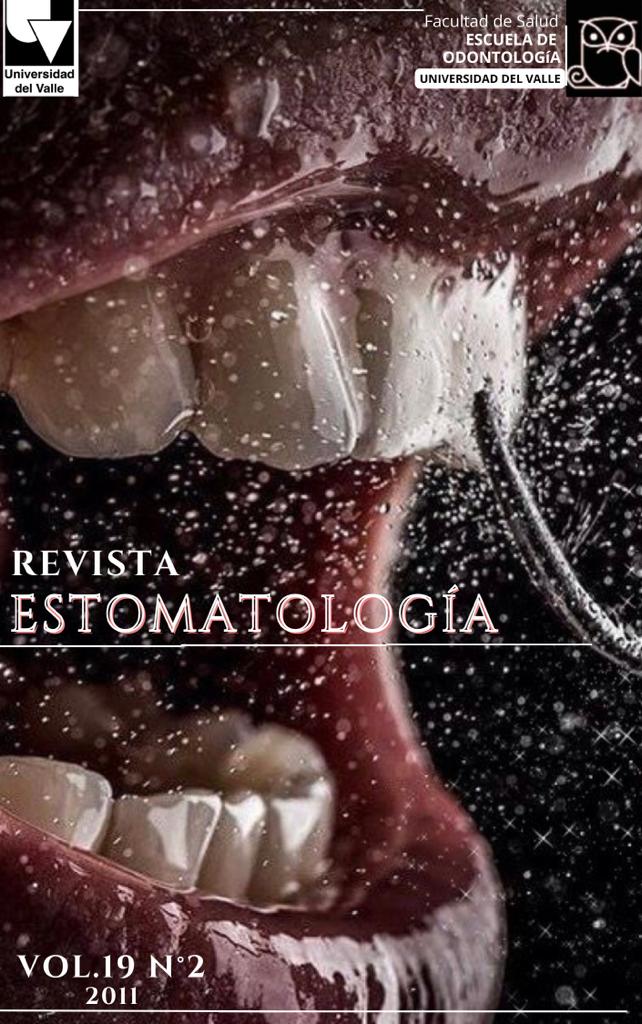Stereomicroscopic analysis of dental materials employed in endodontic exposed to high temperatures
Main Article Content
Objective: To describe the physical estereomicroscopical changes that occur in dental tissues and materials employed in a conventional endodontic treatment after application of high temperatures.
Materials and methods: An in Vitro study was carried out to observe microscopic, structural and physical changes on hard dental tissues (enamel, dentine and cement) and on endodontic materials (gutta-percha Maillefer Dentsply®, endodontical cement based on oxide of zinc-eugenol Eufar®, cement based on epoxic resin Top Seal® Dentsply®, glass ionomer Fuji I® GC America®, silver amalgam GS80® SDI® and composite Point 4® Kerr®) in 124 human teeth, submitted to five temperature ranks (200ºC, 400ºC, 600ºC, 800ºC, 1000ºC).
Results: The studied tissues and dental materials presented great resistance to the high temperatures without varying considerably their micro structure, such as that the physical changes (dimensional stability, cracks, pits, fractures, texture, color, carbonization and incineration) can be observed through estereomicrophotographies and can be associated to each specific rank of temperature.
Conclusions: Some macrostructural changes of dental tissues and the dental materials occur of specific form in each rank of temperature, and for this reason they can be employed in the comparison before and postmortem during the process of identification of burned or charred corpse and human remains.
Key words: Forensic dentistry, human identification, stereomicroscopy, dental materials, high temperatures.
2. Ferreira JL, Espina AL, Barrios FA, Mavaréz MG. Conservación de las estructuras orales y faciales del cadáver quemado. Cien Odontol 2005; 2: 58-65.
3. Norrlander AL. Burned and incinerated remains. In: Bowers CM, Bell GL, Editores. Manual of forensic odontology. Third edition. Colorado Springs: American Society of Forensic Odontology; 1997. p 16-8.
4. Delattre VF. Burned beyond recognition: Systematic approach to the dental identification of charred human remains. J Forensic Sci. 2000; 45: 589-96.
5. Merlati G, Savio C, Danesino P, Fassina G, Menghini P. Further Study of restored and unrestored teeth subjected to high temperatures. J Forensic Odontostomatol 2004;22:17-24.
6. Mazza A, Merlati G, Savio C, Fassina G, Menghini P, Danesino P. Observations on dental structures when placed in contact with acids: Experimental studies to aid identification processes. J Forensic Sci 2005;50:40610.
7. Edgar HJ. Prediction of race using characteristics of dental morphology. J Forens Sci 2005;50:1-5.
8. Williams D, Lewis M, Franzen T, Lissett V, Adams C, Whittaker D, et al. Determination by PCR analysis of DNA extracted from incinerated, deciduous teeth. Sci Justice. 2004;44:89-94.
9. Ministerio de la Protección Social. Resolución Nº 008430/1993 de octubre 4. Por la cual se establecen las normas científicas, técnicas y administrativas para la investigación en salud. (fecha de acceso febrero de
2009). URL disponible en http://www.minproteccionsocial.gov. co/vbecontent/library/documents/Doc NewsNo267711.pdf
10. Asociación Médica Mundial. Principios éticos para las investigaciones médicas en seres humanos. Declaración de Helsinki. Finlandia, junio 1964 (fecha acceso febrero de 2009). URL disponible en http://www.wma.net/s/policy/b3.htm
11. International Organization of Standardization. Dental materials: Testing of adhesion to tooth structure. ISO/TS 11405: 2003.
12. Cohen S, Burns RC. Pathways of the pulp. Eigth edition. St. Louis: Mosby, Inc.; 2002.
13. Moreno S, León ME, Marín L, Moreno F. Comportamiento de los tejidos dentales y de algunos materiales de obturación dental sometidos a altas temperaturas con fines forenses. Colomb Med 2008;39(1):28-46.
14. Rötzscher K, Grundmann C, Benthaus S. The effects of high temperatures on human teeth and dentures. Int Poster J Dent Oral Med. 2004; 6: Poster 213.
15. Fereira JL, Espina A, Ortega AI. Methods for the analysis of hard dental tissues exposed to high temperatures. Forensic Science International 2008; 178:119-124.
16. Savio C, Merlati G, Danesino P, Fassina G, Menghini P. Radiographic evaluation of teeth subjected to high temperatures: Experimental study to aid identification processes. Forensic Science International 2006;158:108-116.
17. Moreno S, Marín L, Merlati G, Savio C, Moreno F. Effects of high temperatures on different dental restorative systems: experimental study to aid identification processes. Journal of Forensic Dental Sciences 2009;1(1):17-23.
Downloads
Los autores/as conservan los derechos de autor y ceden a la revista el derecho de la primera publicación, con el trabajo registrado con la licencia de atribución de Creative Commons, que permite a terceros utilizar lo publicado siempre que mencionen la autoría del trabajo y a la primera publicación en esta revista.

